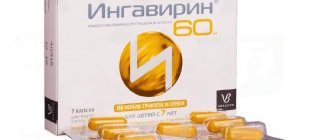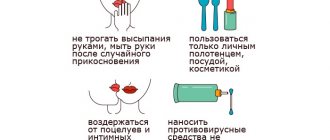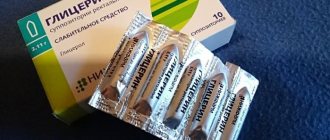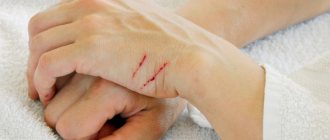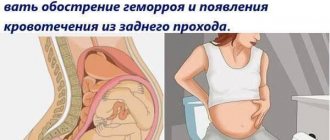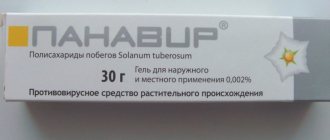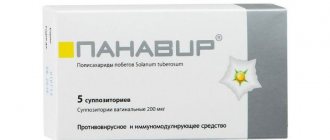The development of a viral infection during pregnancy causes anxiety in a woman. On the one hand, she worries that the virus will worsen the baby’s health, and on the other hand, that treating the infection will negatively affect the development of pregnancy. Therefore, during the gestational period, it is important to treat viral diseases with approved drugs. Often preference is given to the herbal remedy Panavir. Its active substance is obtained from the Solanum tuberosum plant, and its action is aimed at increasing immunity and destroying viruses. How effective is this drug, is it allowed during pregnancy, and what are the rules for taking it?
Composition and release form
There are six known release forms of Panavir, intended for the treatment of various diseases . Their composition and packaging:
| Description | Compound | Package | |
| Solution for intravenous administration | Colorless liquid with a light brown tint | Water, sodium chloride | Ampoules of 5 ml, 2, 5 or 10 ampoules in a pack with instructions for use |
| Gel | Homogeneous white mass | Water, glycerol, macrogol, lanthanum nitrate hexahydrate, sodium hydroxide, ethanol | Aluminum tubes of 3, 5, 10 or 30 g |
| Rectal suppositories | White-yellowish candles in the form of a cylinder or cone | Solid or confectionery fat, emulsifier, paraffin | Polymer blister packs of 5 pcs., 1 or 2 packs in a pack |
| Vaginal suppositories for use in gynecology | Grayish-white translucent candles | Polyethylene oxide, macrogol | 5 pieces. packaged |
| Spray Intim and Inlight | Transparent gel-like mass | Eucalyptus oil, polyethylene glycol, castor oil, water, sodium hydroxide, lanthanum nitrate | Bottle with nozzle 40 ml |
| Toothpaste | White paste | Sodium fluoride, xylitol, sodium monofluorophosphate, calendula extract, D-panthenol, silver citrate | Tube 75 ml |
Pharmacodynamics and pharmacokinetics
Panavir has immunomodulatory and antiviral effects; the product contains extract of potato tops shoots. The active substance of this extract is hexose glycoside (hexahydrate), consisting of rhamnose, mannose, galactose, glucose, arabinose, uronic acids and xylose. When treated with medication, the production of interferons is activated and nonspecific immunity increases.
The antiviral effect of the drug occurs due to the active substance inhibiting the synthesis of viral DNA in cells affected by it. Therapeutic doses of Panavir are well tolerated and do not exhibit mutagenic, allergenic, teratogenic, embryotoxic, or carcinogenic effects on the body. The drug has analgesic and anti-inflammatory activity, has a regenerative effect, accelerates the process of scarring of ulcers, has an antipyretic effect, and improves the functions of the optic nerve and retina.
With external and local use of Panavir, the active components are not detected in the systemic circulation; with intravenous administration, polysaccharides are detected in the blood five minutes after entry. The active substances are captured by the cells of the reticuloendothelial system of the liver and spleen. The remains are excreted by the lungs and kidneys. The removal process takes 20-30 minutes.
Indications for use
Depending on the form of release, the indications for use of the drug differ. The instructions highlight the following:
- herpesvirus infections (herpes zoster, ophthalmic herpes, recurrent genital herpes);
- secondary state of immunodeficiency due to infectious diseases;
- cytomegalovirus infection (in the treatment of women with miscarriage, to prepare for conception during chronic viral infection);
- long-term non-scarring ulcers of the duodenum or stomach;
- papillomavirus infection;
- rheumatoid arthritis due to herpes;
- tick-borne encephalitis (as part of complex treatment);
- influenza, acute respiratory viral infections (ARVI);
- chronic bacterial prostatitis;
- skin diseases and infectious-inflammatory diseases of the mucous membranes.
Special instructions for the use of the drug Panavir
If the solution becomes cloudy, the drug is considered unsuitable for use. Use during pregnancy and lactation Use during pregnancy is possible only if the expected benefit to the mother outweighs the potential risk to the fetus. If it is necessary to use the drug during breastfeeding, you must stop breastfeeding. Children. The drug is not recommended for use in children under 12 years of age (efficacy and safety have not been established). The ability to influence the reaction rate when driving a vehicle or working with other mechanisms. Panavir does not affect the reaction rate when driving vehicles or operating other mechanisms.
Directions for use and dosage
Instructions for use of Panavir differ depending on the release form. Thus, dental paste is used to cleanse the oral cavity for candidiasis or herpes. A small amount of it is applied to a toothbrush, after which the teeth are brushed in a circular motion with gentle massaging of the gums. The mouth is rinsed with a small amount of water. The procedure is repeated twice a day.
Solution
Panavir in ampoules, according to the instructions, can be administered intravenously slowly or in a stream. One ampoule contains 200 mcg of active ingredient, which is a therapeutic dose. For herpes and tick-borne encephalitis, the drug is used twice with an interval of 24-48 hours. Treatment is repeated after a month. Therapy for papilloma and cytomegalovirus infections involves using the medication three times with an interval of 48 hours during the first week and twice with a wait of 72 hours between injections in the second week.
In case of exacerbation of peptic ulcer, injections are given five times every other day, the course of treatment lasts 10 days. For rheumatoid arthritis, which occurs against the background of the development of herpes, 5 injections are given at intervals of 24-48 hours, the course is repeated after two months. For influenza and ARVI, doctors give 2 intravenous injections 18-24 hours apart. To eliminate exacerbation of chronic bacterial prostatitis, 5 intravenous injections are used with a period of 48 hours.
Panavir candles
Panavir suppositories are divided into rectal and vaginal. They should be used for their intended purpose. The instructions suggest that the first suppositories are inserted into the anus for prostatitis and for the treatment of children, vaginal suppositories are used by women to treat genital herpes. Depending on the form of release and purpose, the dosages of the drugs differ.
Rectal
Suppositories for rectal use are intended for the treatment of herpes virus infection and tick-borne encephalitis . For this, two candles are used with an interval of 24-48 hours. If necessary, a month later the treatment is repeated. According to the instructions, to eliminate signs of flu, use one suppository every 24 hours for a course of 5 days. For the treatment of cytomegalovirus infection and papillomas caused by the human papillomavirus, the use of one suppository three times (with an interval of 48 hours) in the first week and twice (with an interval of 72 hours) in the second is indicated.
Vaginal
Intravaginal suppositories (may be called tablets) are inserted deep into the vagina and are used by adult patients. They are inserted as deeply as possible, for convenience, bend your knees and lie on your back. Every day for five days one candle is used. Repeating treatment is possible after medical consultation. It is advisable to administer suppositories in the evening, before bedtime. Before use, wash the external genitalia and dry.
Articles on the topic
- Unstable erection in men
- Isoprinosine - instructions for use, dosage for children and adults, contraindications and reviews
- Dalatsin - instructions and reviews
Gel Panavir
The gel form of the drug is mistakenly called Panavir ointment. According to the instructions, the gel is applied in a thin layer to the affected areas of the skin or mucous membranes up to five times a day. The course of treatment is up to five days; if necessary, the doctor extends it to 10 days. The gel can be applied to the affected vagina or urethra and is used at the first signs of the disease.
The use of the medication relieves itching, tingling, a feeling of tension, redness of the skin, and prevents the development of herpetic rashes. If you start using the product as early as possible, bubbles may not appear or may be found in minimal quantities. In 75% of cases, using the gel to treat rashes on the skin and mucous membranes leads to stable remission. The drug can be used to treat molluscum contagiosum, accelerate healing after cryodestruction, and laser coagulation.
Spray Panavir
According to the instructions, Panavir intimate spray is intended for treating the genitals. The second type of Inlight spray is used for application to the oral cavity. Before use, the bottle of product is shaken and held vertically. It is necessary to apply the medicine to the affected areas by pressing the valve 1-2 times. There is a special nozzle for intravaginal use.
After applying the gel, you can rub it in with light massaging movements or leave it to absorb on its own. A special nozzle allows you to administer the product intravaginally. If you use another nozzle, it can be inserted inside 2 cm, not deeper. To spray the spray in the mouth, place it on a flat surface, tilt the head to allow the nozzle to penetrate 1-2 cm into the mouth or nose, and press the valve 2-3 times. To prevent influenza, the spray is used twice a day.
Instructions:
| Solution for intravenous administration | 1 amp. or 1 fl. |
| active substance: | |
| Panavir® (purified extract of shoots of the Solanum tuberosum plant, the main active ingredient is a hexose glycoside consisting of glucose, rhamnose, arabinose, mannose, xylose, galactose, uronic acids) | 0.2 mg per 1 amp. or 1 fl. |
| excipients: 0.9% sodium chloride solution |
solution for intravenous administration 0.04 mg/ml in ampoules or bottles of 5 ml; solution for intravenous administration 0.1 mg/ml in ampoules or vials of 2 ml; solution for intravenous administration 0.2 mg/ml in ampoules or vials of 1 ml
2 or 5 or 10 ampoules or bottles in a blister pack; in a cardboard pack of 1 or 2 blister packs with an ampoule knife or ceramic scarifier.
| Gel for external and local use | 1 tube |
| active substance: | |
| Panavir® (purified extract of shoots of the Solanum tuberosum plant, the main active ingredient is a hexose glycoside consisting of glucose, rhamnose, arabinose, mannose, xylose, galactose, uronic acids) | 0.002 g per 100 g |
| excipients: glycerin; polyethylene oxide 400; polyethylene oxide 4000; ethanol; sodium hydroxide; lanthanum nitrate; purified water |
in aluminum or polymer tubes of 3 and 30 g; in a cardboard pack 1 tube.
| Rectal suppositories | 1 sup. |
| active substance: | |
| Panavir® (purified extract of shoots of the Solanum tuberosum plant, the main active ingredient is a hexose glycoside consisting of glucose, rhamnose, arabinose, mannose, xylose, galactose, uronic acids) | 200 mcg |
| excipients: suppository weight 1.2 g - solid confectionery fat based on plasticized lard or solid fat - 80–90%; paraffin - 5–10%; emulsifier T-2 - 5–10% |
in a blister pack 5 pcs.; in a cardboard pack 1 package.
Description of the dosage form
Solution for intravenous administration: clear, colorless liquid, odorless, salty taste.
Gel for external and local use: a homogeneous white mass with a slight specific odor.
Rectal suppositories: white with a yellowish tint, with a specific odor, cone-shaped or cylindrical; The presence of yellowish-gray inclusions with a specific odor is allowed.
pharmachologic effect
Pharmacological action - antiviral, immunomodulatory.
Pharmacokinetics
Solution for intravenous administration: with intravenous administration, polysaccharides are detected in the blood within 5 minutes after administration and are captured by the cells of the reticuloendothelial system of the liver and spleen. Elimination begins quickly; after 20–30 minutes, polysaccharides are found in the urine and exhaled air.
Pharmacodynamics
Panavir® is a high molecular weight polysaccharide belonging to the class of hexose glycosides.
The drug Panavir® is an antiviral and immunomodulatory agent. Increases the body's nonspecific resistance to various infections and promotes the induction of interferon.
In therapeutic doses, the drug is well tolerated.
Tests have shown the absence of mutagenic, teratogenic, carcinogenic, allergenic and embryotoxic effects.
Experimental studies have not established any negative effects on reproductive function and fetal development. It has anti-inflammatory properties in experimental models of exudative edema, chronic proliferative inflammation and in the pseudoallergic inflammatory reaction test to concanavalin A.
An analgesic effect has been shown in models of neurogenic pain and pain caused by the inflammatory process. The duration of the increase in pain sensitivity thresholds during thermal stimulation is positive and dose-dependent.
Has an antipyretic effect.
It has wound-healing properties in a gastric ulcer model.
Indications of the drug Panavir®
Solution for intravenous administration and rectal suppositories:
herpesvirus infections of various localizations (including recurrent genital herpes, herpes zoster and ophthalmic herpes);
secondary immunodeficiency states due to infectious diseases;
cytomegalovirus infection, incl. in patients with recurrent miscarriage;
can be used in women with chronic viral infection and interferon deficiency in preparation for pregnancy;
papillomavirus infection (anogenital warts) in complex therapy;
complex therapy of gastric and duodenal ulcers in patients with long-term scarring ulcers and symptomatic ulcers of the gastroduodenal zone;
treatment of tick-borne encephalitis in order to reduce the viral load and relieve neurological symptoms (anisoreflexia, decreased reflexes, pain in the exit points of cranial nerves, nystagmus) in complex therapy;
complex treatment of immunocompromised patients with rheumatoid arthritis to enhance the analgesic and anti-inflammatory effect of concomitant therapy for herpesvirus infection.
Solution for intravenous administration (optional):
complex therapy of ARVI and influenza;
complex therapy of chronic bacterial prostatitis.
Gel for external and local use:
infectious and inflammatory skin diseases caused by the herpes simplex virus types I and II (including genital herpes) and Herpes Zoster (shingles);
papillomavirus infection (applied to the sites of destruction of papillomas until complete healing) - in complex therapy.
Contraindications
Solution for intravenous administration and rectal suppositories:
individual intolerance;
presence of allergies to the constituent components of the drug: glucose, mannose, rhamnose, arabinose, xylose;
severe pathology of the kidneys and spleen;
children's age up to 12 years.
Solution for intravenous administration (optional):
lactation period.
Gel for external and local use:
presence of allergies to the constituent components of the drug: glucose, mannose, rhamnose, arabinose, xylose.
Use during pregnancy and breastfeeding
Solution for intravenous administration and rectal suppositories: use during pregnancy is possible only if the expected benefit to the mother and fetus outweighs the potential risk of adverse events. If it is necessary to use the drug during lactation, breastfeeding should be stopped.
Side effects of the drug Panavir®
Solution for intravenous administration and rectal suppositories: the drug is well tolerated, possible complications may be associated with individual intolerance and hypersensitivity to the components of the drug.
However, if any unwanted side effects occur, you should stop administering the drug and consult your doctor.
Gel for external and local use: rapid redness and itching of the skin or mucous membrane in the area where the gel is applied may occur.
Interaction
Not found.
Overdose
Solution for intravenous administration: in case of overdose, reversible dysfunction of the kidneys and spleen is possible.
Rectal suppositories: overdose is unlikely. Reversible dysfunction of the kidneys and spleen is possible.
Directions for use and doses
Solution for intravenous administration: intravenously in a slow stream - 200 mcg (contents of 1 amp.).
Panavir® in solution is used for intravenous administration of a therapeutic dose of 200 mcg (contents of one ampoule or bottle) of the active substance. For the treatment of herpes virus infections and tick-borne encephalitis, Panavir is used twice with an interval of 48 or 24 hours. If necessary, the course of treatment can be repeated after a month. For the treatment of cytomegalovirus and papillomavirus infections, Panavir® is used three times during the first week with an interval of 48 hours and twice during the second week with an interval of 72 hours. For the treatment of gastric and duodenal ulcers in the acute phase and symptomatic ulcers of the gastroduodenal zone, 5 i.v. injections every other day for 10 days.
For herpes virus infection in patients with rheumatoid arthritis - 5 injections with an interval of 24-48 hours, if necessary, repeat the course after 2 months. For the treatment of patients with ARVI and influenza, 2 IV injections are used with an interval of 18–24 hours.
Panavir® should be administered slowly.
Gel for external and local use: apply a thin layer to the affected areas of the skin or mucous membrane without rubbing 5 times a day. Duration of treatment is 4–5 days. The course of treatment can be extended up to 10 days.
Intravaginally. A small amount of gel is inserted vaginally and evenly distributed in a thin layer along the vaginal walls. Treatment is continued until clinical manifestations disappear completely.
Rectal suppositories: rectally, the dosing regimen is similar to the dosing regimen of the solution for intravenous administration (in the ratio of 1 supp. - 1 amp.).
Use in pediatrics
Panavir® is prescribed to children over 12 years of age at a dose of 100 mcg (half the contents of 1 amp.), IV slowly.
special instructions
Solution for intravenous administration: when used in preparation for pregnancy, it helps reduce the frequency of reproductive losses due to cytomegalovirus and herpesvirus infections.
If the solution becomes cloudy, the drug is considered unsuitable for use.
Gel for external and local use: it is recommended to start treatment at the earliest possible stage of the disease, at the first signs (itching, tingling, redness, feeling of tension), in this case the development of the vesicular stage of the disease can be completely prevented.
Panavir® gel cannot be used in ophthalmology. When applying the gel to the face, avoid getting it into the eyes.
A comment
Full information about the drug is on the website www.panavir.ru.
Storage conditions for the drug Panavir®
In a dry place, protected from light, at a temperature not exceeding 25 °C.
Panavir during pregnancy
Before using the product during pregnancy, you should consult your doctor. The solution and gel can be used when the benefit to the mother exceeds the risk to the child. During treatment with Panavir solution and rectal suppositories, breastfeeding is prohibited.
When carrying a child, the instructions prohibit the use of rectal and vaginal suppositories, although no carcinogenic, mutagenic, embryotoxic or teratogenic effects of the drug have been identified. Sprays are allowed during pregnancy.
Can pregnant women use gel, spray, and suppositories?
Panavir has a mild effect on the body. It copes well with its tasks, and, as a number of studies show, it does not have a negative impact. Therefore, if indicated, a specialist may prescribe this medication.
Of all the forms, only suppositories are contraindicated during pregnancy; they can be prescribed in rare cases according to strict indications.
In the early stages
In the early stages of pregnancy, any intervention in the development of the fetus can lead to disastrous consequences, so if possible, you should avoid any medications. But if indicated, the doctor may prescribe Panavir. In the early stages, the drug is usually used in the form of an injection solution - its composition is as safe as possible, and among the additional components it includes only water. Other forms are practically not used.
In the 2nd trimester
The second trimester is considered less risky for taking medications, since the vital organs of the fetus are already formed.
However, Panavir can only be used with the prescription of a specialist. Usually an injection solution is used.
Suppositories and gel are indicated only if the potential benefits from them are greater than the risks. However, doctors often prescribe these forms, which are considered quite safe.
In the 3rd trimester
It is not dangerous to use the product in the third trimester if prescribed by a doctor. This applies to solution, gel and suppositories. The spray can be used by pregnant women without restrictions, since the concentration of the active substance in it is very small, and it only acts locally.
Panavir for children
Panavir solution can be used in the treatment of children over 12 years of age; for them, a dosage of half an ampoule or 100 mcg at a time is prescribed . Other dosage forms of the drug are well tolerated and have low toxicity, so in theory they can be used to treat children. Due to the lack of safety information, there is a limitation on this.
Suppositories for intravaginal administration are contraindicated in patients under 18 years of age; rectal suppositories are used to a limited extent for the treatment of influenza and rotavirus infection. The gel can be used in children of different ages to treat herpes. Inlite gel spray , also called children's spray, is used without restrictions. They treat the throat, mouth, nose and pharynx to speed up recovery and stop the course of a viral infection. The spray helps with a runny nose, viral tonsillitis, pharyngitis, and herpangina.
Folk remedies and methods of prevention
An expectant mother should think about preventing possible infections even at the stage of pregnancy planning. It is important to undergo all necessary examinations and take measures to manage immunity.
The following tips should be taken into account:
- It is necessary to eliminate bad habits.
- Hypothermia or overheating should not be allowed.
- Women prone to herpes should use sunscreen during the hot season (since ultraviolet radiation promotes the activation of the virus).
- It is important to avoid contact with infected people.
- To strengthen the immune system, you need to take care of the right diet. It should include fruits and vegetables rich in vitamin C.
- The expectant mother should avoid stress, have proper rest and get enough sleep.
- When the herpes virus manifests itself, it is useful to lubricate the affected skin with aloe juice, fir oil, chamomile and calendula decoction, strong tea leaves and tea tree ether.
During pregnancy, many medications pose a danger to the expectant mother. But infections that occur at this time can be fraught with serious consequences. Therefore, Panavir can be used while waiting for the baby, but only with a doctor’s prescription and strictly in accordance with his recommendations.
Side effects of Panavir
The drug is well tolerated, so it is unlikely that adverse reactions will develop during its use. The instructions include the following possible consequences:
- increased sensitivity of the skin or mucous membranes;
- itching, redness of the skin;
- allergic reactions, urticaria, swelling, hyperemia;
- nausea, vomiting, dyspepsia;
- flatulence;
- headache, dizziness;
- vaginal discharge of unknown etiology.
Analogs
Drugs with antiviral and immunomodulatory effects can replace the drug . There are no analogues to Panavir in composition - this is a unique medicine. Drug substitutes are:
- Arbidol - antiviral capsules based on umifenovir.
- Yodantipyrine is an immunomodulatory tablet containing iodophenazone.
- Detoxopirol is an analgesic tablet containing natural plant extracts.
- Ferrovil is an immunomodulating solution based on a complex of sodium deoxyribonucleate with iron.
- Kagocel is an antiviral tablet based on the component of the same name.
- Lavomax - tablets containing tilorone, which stimulate the production of interferons.
- Oxoline is an antiviral ointment against influenza and herpes based on oxoline.
- Ergoferon – lozenges based on antibodies to interferon gamma.
- Ingavirin is an analogue of Panavir in the form of anti-inflammatory capsules containing pentanedioic acid imidazolylethanamide.
Treatment regimen for children under 12 years of age
For children, the dose of medication is reduced to 0.1 mg. When treating herpes and papillomas, doctors recommend taking three doses of the solution in the first seven days with a break of two days. In the second week, the number of injections is reduced to two, and the break between them is reduced to three days.
Popular Is it possible to become a genius thanks to piracetam injections?
In the presence of encephalitis and herpes, doctors recommend giving two injections with a break of one day to two days. After this, treatment can be repeated after a month.
Panavir price
You can buy the product in pharmacies or online. Approximate cost in Moscow:
| Type of drug release | Internet price tag, rubles | Pharmacy cost, rubles |
| Gel 3 g | 140 | 149 |
| Toothpaste 75 ml | 198 | 210 |
| Gel 30 g | 834 | 890 |
| Vaginal suppositories 200 mcg 5 pcs. | 1625 | 1700 |
| Ampoule solution 0.004% 5 ml 2 pcs. | 1633 | 1700 |
| Rectal suppositories 200 mcg 5 pcs. | 1698 | 1750 |
| Ampoules 5 ml 5 pcs. | 3748 | 3800 |
